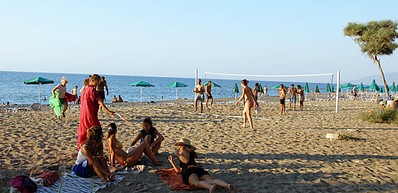Ideal sea temperatures, clear waters and rich coastal reefs
Paphos is located in the west of Cyprus and is one of the main diving hubs of the country. Cyprus lies in the crossroads of three continents which gives the country its unique atmosphere of east meets west.
Clear seas and warm waters make Pafos ideal for diving. Sea temperatures around the island range from 27 to 16 ºC, resulting in one of the longest diving seasons in the Mediterranean, while the absence of plankton makes for great visibility.
The underwater coastal reefs teem with a wide variety of colourful fish, sponges, coral, sea anemones, octopus, mussels and the ubiquitous sea urchin providing a spectacular picture. Sea turtles can be spotted regularly, thanks to a turtle conservation project that has increased their numbers around the island considerably.
Spectacular underwater caves and tunnels and a number of interesting paths are just waiting to be explored, while the remains of ancient amphora and stone anchors make it a veritable adventure.
Akamas National Park lies 12km west of Paphos and is home to some excellent dive sites with lots of marine life. The whole area is a marine park so is a protected area from fishing which is why the marine life here is so abundant compared to the Cyprus reefs just a short distance away. St Georges Island in the Akamas is one of the only deep wall dives in the area and caters for all levels of experience. As you are swimming along the wall its worth taking time to explore any recesses and overhangs for the marine life hiding there and see if you can find a hidden octopus or tiny critters such as colourful nudibranchs. Another site in the Akamas is Lara Valley which offers overhangs, crevasses and if you are lucky there is a chance of even spotting a turtle around here during the breeding season.
Nearer to Paphos one relatively easy but stunning underwater geological feature is the Amphitheatre which is a naturally formed amphitheatre at the shallow 9-12m. The shallow depth and rock formation create some very pretty light effects and is a great spot for photographs.
Open water (OW) qualification required. Access is from the shore just past the headland at Coral Bay, a short walk down the rocks.
This is a particularly popular dive, ranging from 4 metres to some 12 metres. It takes its name from the natural formation resembling an amphitheatre that was cut out of the rock by sea currents.
Besides the magnificent rock formations, there is an abundance of marine life to admire, including groupers, eels and cuttlefish.
Last but not list divers can experience the unique Amphorae Caves. A famous dive to a depth up to 12 meters. There are some caves to explore, including one with the top-encrusted amphorae. A team of American archaeologists who investigated this region feel that this was created by movements in the sea over the past two thousand years
Read more





















